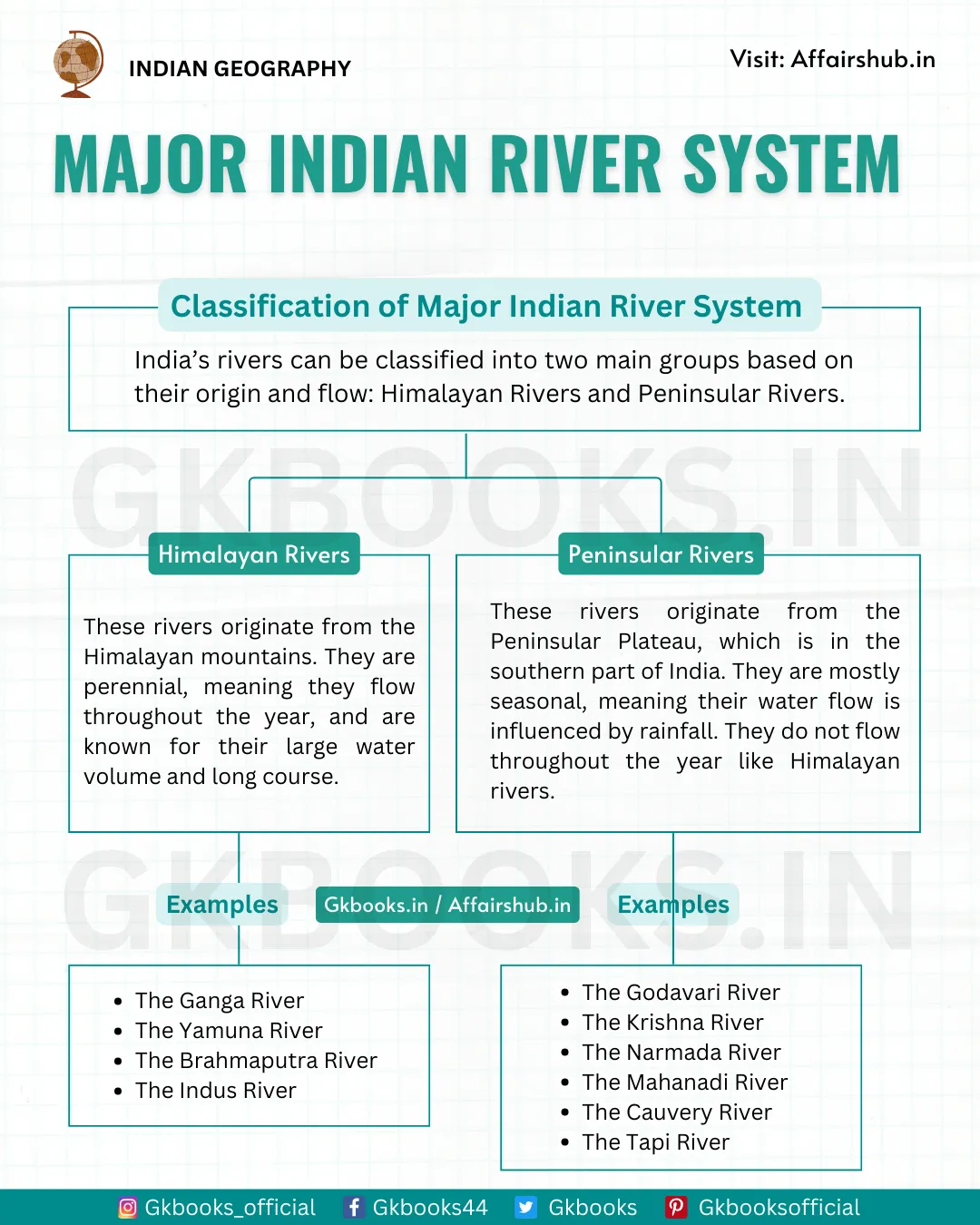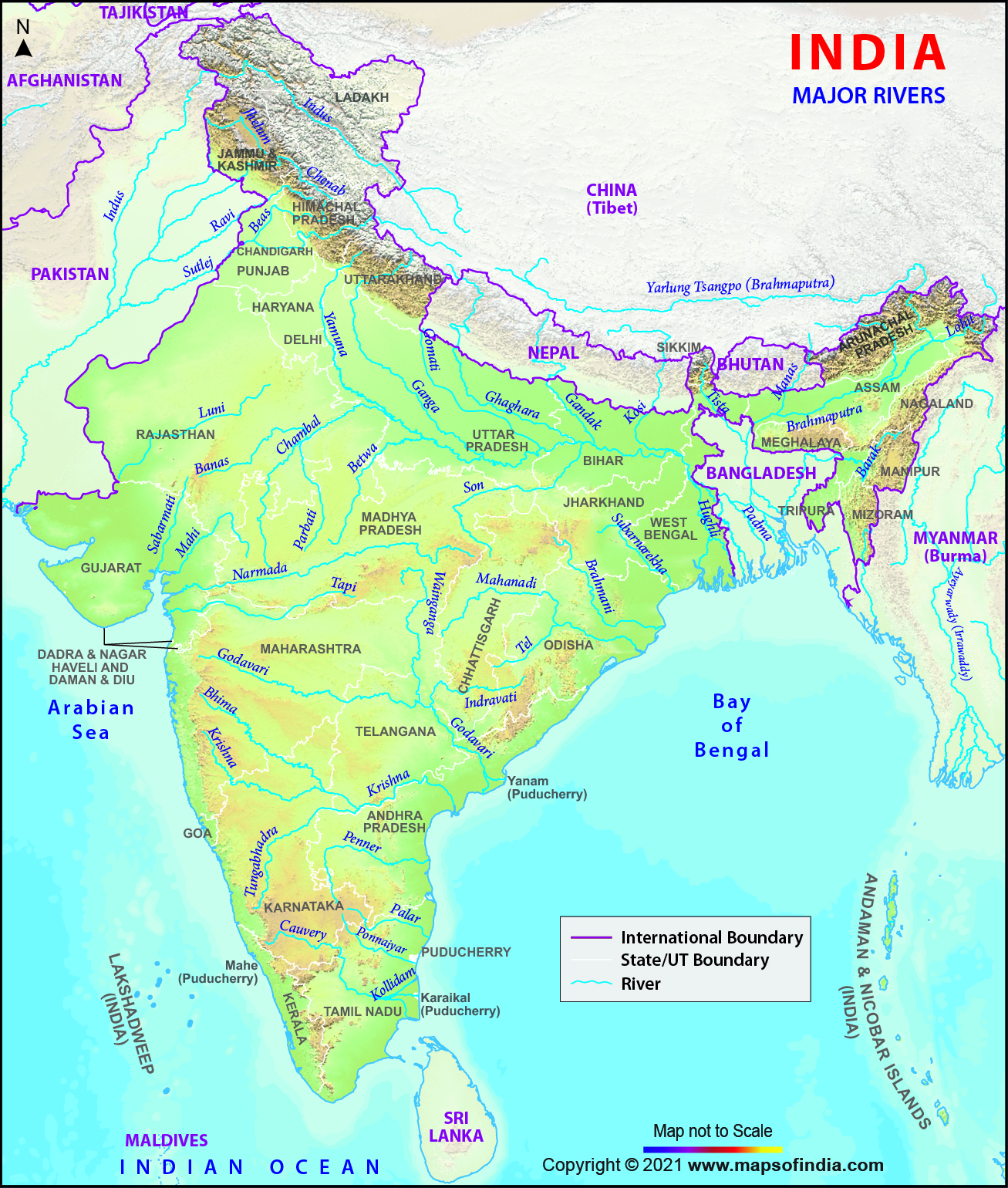India is known as the “Land of Rivers” because it has many rivers that are very important for the country. These rivers, both from the tall Himalayas and the lower Peninsular region have played a big role in shaping India’s land, culture, and economy for a long time. They provide water for people, animals, and plants, and help in farming, transportation, and many other activities.
✅ Explore the Complete List of Indian Geography Topics
Major Indian River System
The Indian River system can be classified into two major groups: the Himalayan River system and the Peninsular River system. Let’s briefly discuss them.
Himalayan Rivers
The Himalayan rivers are perennial, meaning they are fed by glaciers and rainfall, ensuring a constant flow of water throughout the year.
Major Himalayan Rivers:
- Ganga River: Revered as sacred, the Ganga originates from the Gangotri Glacier in Uttarakhand and flows across North India, supporting millions of lives.
- Brahmaputra River: Starting in Tibet as the Tsangpo, it enters India through Arunachal Pradesh and is crucial for the northeastern region.
- Indus River: Originating in Tibet, the Indus flows through Ladakh before entering Pakistan, forming an essential part of the Indus Valley Civilization.
Peninsular Rivers
Peninsular rivers, unlike their Himalayan counterparts, are largely rain-fed and exhibit seasonal flow patterns.
Key Peninsular Rivers
Mahanadi River
- The Mahanadi River is a major east-flowing river in India, originating in the hills of Chhattisgarh and flowing through Odisha before draining into the Bay of Bengal.
- It is known for its fertile delta, the Hirakud Dam (one of the longest dams in the world), and its significance in agriculture and hydropower.
Godavari River
- The Godavari River, often referred to as the “Dakshin Ganga”, is the second-longest river in India, originating in the Western Ghats of Maharashtra and flowing through Telangana, Andhra Pradesh, and other states before emptying into the Bay of Bengal.
- It is renowned for its extensive basin, cultural significance, and the Kumbh Mela held at Nashik on its banks.
Krishna River
- The Krishna River is one of the major rivers in India, originating from the Western Ghats near Mahabaleshwar in Maharashtra and flowing through Karnataka, Telangana, and Andhra Pradesh before emptying into the Bay of Bengal.
- It is known for its extensive basin, the Krishna Delta, and major projects like the Nagarjuna Sagar Dam and Srisailam Dam.
Kaveri River
- The Kaveri River (or Cauvery) is a sacred river in South India, originating at Talakaveri in the Western Ghats of Karnataka and flowing through Tamil Nadu before draining into the Bay of Bengal.
- It is vital for agriculture, known for the Kaveri Delta, and is a source of water disputes between Karnataka and Tamil Nadu.

Major River Basins in India
The Ganga Basin
The Ganga Basin is the largest in India, covering over 11 states like Uttar Pradesh, Bihar, and West Bengal. It has many important rivers, such as the Yamuna, Son, and Gomti. This basin is very fertile and supports a large population of farmers.
The Brahmaputra Basin
The Brahmaputra Basin is located in the northeastern part of India, including states like Arunachal Pradesh, Assam, and Meghalaya. It is known for its rich wildlife, wetlands, and large floodplains that help in agriculture.
The Indus Basin
The Indus Basin stretches across India and parts of Pakistan. It includes rivers like the Jhelum, Chenab, Beas, Satluj, and Ravi. This basin is crucial for farming and also has a significant role in the region’s politics and history.
The Godavari Basin
The Godavari River Basin flows through states like Maharashtra, Telangana, and Andhra Pradesh. It is the second-largest river basin in India and provides water for irrigation, supporting farming and agriculture.
The Krishna Basin
The Krishna Basin covers parts of Karnataka, Maharashtra, and Andhra Pradesh. The Krishna River, along with its tributaries like the Tungabhadra, provides water for irrigation in these regions, making it an important resource for farmers.
The Mahanadi and Kaveri Basins
The Mahanadi Basin, found in Odisha and Chhattisgarh, and the Kaveri Basin in Tamil Nadu and Karnataka, are vital for both irrigation and producing electricity through hydropower. These rivers are also important for the region’s agriculture.

Rivers and Civilization
Rivers have played a very important role in the development of civilizations in India. From ancient times, people settled near rivers because they provided water for drinking, farming, and transportation. Let’s see how rivers shaped India’s history and culture:
- Ancient Indus Valley Civilization: One of the oldest civilizations in the world, the Indus Valley Civilization, developed around the Indus River. Cities like Mohenjo-Daro and Harappa were built near the river. People used the river water for farming, which helped them grow crops like wheat and barley. The river also helped in trade and transportation.
- Vedic Period: During the Vedic period, people settled near rivers like the Ganga and Yamuna. These rivers were considered sacred, and many rituals and ceremonies were performed on their banks. The fertile soil near the rivers made farming easier, and people grew rice, pulses, and other crops.
- Mughal Era: The Mughal rulers also understood the importance of rivers. They built beautiful cities like Agra and Delhi near the Yamuna River. The rivers helped in irrigation, which improved agriculture. The Mughals also built gardens and forts near rivers, which added to the beauty of their empire.
- British Era: When the British came to India, they used rivers for transportation and trade. They built canals and dams to control the water and use it for farming. Cities like Kolkata, located near the Hooghly River, became important trading centers.
- Cultural Practices: Rivers are not just important for survival; they are also part of India’s culture. Many festivals, like Kumbh Mela, are celebrated on river banks. Rivers like the Ganga are considered holy, and people believe that bathing in them can wash away sins.
- Modern Times: Even today, rivers are important for India. They provide water for drinking, farming, and industries. However, pollution and overuse are causing problems for rivers. It is important to protect and conserve them for future generations.
Ecological Importance of Rivers
Rivers are not just important for people; they are also vital for the environment. Indian rivers are like lifelines for nature, supporting a wide variety of plants and animals. Let’s explore their ecological importance in simple terms:
- Biodiversity Hotspots: Rivers are home to countless aquatic species, such as fish, turtles, frogs, and even dolphins (like the Ganges River Dolphin). Many birds, insects, and plants also depend on rivers for survival. This makes rivers biodiversity hotspots, meaning they are rich in different kinds of life.
- Nourishing Forests and Wetlands: Rivers provide water to nearby forests and wetlands. These areas are habitats for many animals and plants. For example, the Sundarbans, a mangrove forest in West Bengal, depends on rivers for freshwater. Wetlands, like the Keoladeo National Park in Rajasthan, are also fed by rivers and are important for migratory birds.
- Supporting Agriculture: Rivers supply water for farming, which is the backbone of India’s economy. The fertile soil near rivers, called alluvial soil, is perfect for growing crops like rice, wheat, and sugarcane. Without rivers, farming would be very difficult.
- Regulating Climate: Rivers help regulate the local climate. The water in rivers absorbs heat, which keeps the surrounding areas cooler. They also contribute to rainfall through the water cycle. For example, evaporation from rivers adds moisture to the air, which can lead to rain.
- Preventing Soil Erosion: Rivers help maintain the soil by preventing erosion. The plants and trees along riverbanks hold the soil together, stopping it from being washed away during heavy rains. This is why riverside areas are often lush and green.
- Recharging Groundwater: Rivers play a key role in recharging groundwater. When rivers flow, some of the water seeps into the ground, filling underground reservoirs. This groundwater is used for drinking and irrigation, especially during dry seasons.
- Facing Challenges: Sadly, many Indian rivers are facing problems like pollution, overuse, and dams. These issues harm the plants and animals that depend on rivers. It’s important to protect rivers by reducing pollution, using water wisely, and conserving their ecosystems.
Challenges Facing Indian Rivers
- Pollution: Rivers like the Ganga and Yamuna are very polluted because of untreated sewage and waste from factories. This makes the water unsafe for people and animals.
- Overexploitation: Too much water is being taken from rivers for farming and factories. This reduces the flow of water, making the rivers weaker and less helpful to the environment.
- Climate Change: Changes in the climate, like melting glaciers and unpredictable rainfall, are making river systems less stable. This can lead to floods or droughts, affecting people who depend on the rivers.
Government Initiatives for River Conservation
- National Mission for Clean Ganga (NMCG): This mission was started to clean and improve the health of the Ganga River. It works to remove pollution and restore the river’s natural beauty.
- Interlinking of Rivers Project: This project aims to connect different rivers in India. By linking them, the government hopes to share water more fairly across the country, especially in areas facing water shortages.
Conclusion
Indian rivers are the veins of the country, nurturing its people and ecosystems. Protecting and preserving these rivers is not just an environmental responsibility but a duty toward future generations.
FAQs
Indian rivers are classified into Himalayan rivers and Peninsular rivers.
The Ganga is revered in Hinduism as a symbol of purity and spiritual cleansing.
Climate change leads to melting glaciers and altered rainfall patterns, disrupting river ecosystems.
Rivers provide irrigation, making agriculture possible in many regions of India.
Initiatives like the National Mission for Clean Ganga and the Interlinking of Rivers Project focus on rejuvenation and sustainable management of rivers.

